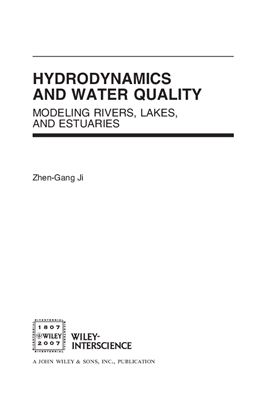Wiley, 2008, 676 Pages
This reference gets you up to speed on mathematical modeling for environmental and water resources management. With a practical, application-oriented approach, it discusses hydrodynamics, sediment processes, toxic fate and transport, and water quality and eutrophication in rivers, lakes, estuaries, and coastal waters. This is a core reference for water quality professionals and an excellent text for graduate students.
The objective of this book is to present an integrated coverage of hydrodynamics, sediment processes, toxic fate and transport, and water quality and eutrophication in surface waters, including rivers, lakes, estuaries, and coastal waters. The book is intended to serve as a reference book for graduate students and practicing professionals with interest in surface water processes and modeling. Mathematical modeling of surface waters has made great progress in past decades and has become a powerful tool for environmental and water resources management. There are growing needs for integrated, scientifi cally sound approaches that identify surface water problems and simulate these waterbodies numerically.
This book illustrates principles, basic processes, mathematical descriptions, and practical applications associated with surface waters. Instead of trying to give detailed coverage of every aspect of hydrodynamics, sediment transport, toxics, and eutrophication processes, this book focuses on solving practical problems in rivers, lakes, estuaries, and coastal waters. After Chapter 1 (Introduction), each of the next 5 chapters ( 2 – 6 ) is devoted to one basic and important topic: hydrodynamics, sediment transport, pathogens and toxics, water quality and eutrophication, and exteal sources and total daily maximum load (TMDL), respectively. Chapter 7 provides general discussions on mathematical modeling and statistical analysis. Based on the theories and processes
presented in Chapters 2 – 7 , rivers, lakes, and estuaries and coastal waters are discussed in Chapters 8 , 9 , and 10 , respectively. Each chapter (after Chapter 1 ) is organized as follows: it begins with an introduction of basic concepts, proceeds to discussions of physical, chemical, and/or biological processes and their mathematical representations, and concludes with case studies. Organizing the book in this application - oriented approach allows readers to easily locate information that is needed for their studies and to focus on the relevant chapters – sections.
This reference gets you up to speed on mathematical modeling for environmental and water resources management. With a practical, application-oriented approach, it discusses hydrodynamics, sediment processes, toxic fate and transport, and water quality and eutrophication in rivers, lakes, estuaries, and coastal waters. This is a core reference for water quality professionals and an excellent text for graduate students.
The objective of this book is to present an integrated coverage of hydrodynamics, sediment processes, toxic fate and transport, and water quality and eutrophication in surface waters, including rivers, lakes, estuaries, and coastal waters. The book is intended to serve as a reference book for graduate students and practicing professionals with interest in surface water processes and modeling. Mathematical modeling of surface waters has made great progress in past decades and has become a powerful tool for environmental and water resources management. There are growing needs for integrated, scientifi cally sound approaches that identify surface water problems and simulate these waterbodies numerically.
This book illustrates principles, basic processes, mathematical descriptions, and practical applications associated with surface waters. Instead of trying to give detailed coverage of every aspect of hydrodynamics, sediment transport, toxics, and eutrophication processes, this book focuses on solving practical problems in rivers, lakes, estuaries, and coastal waters. After Chapter 1 (Introduction), each of the next 5 chapters ( 2 – 6 ) is devoted to one basic and important topic: hydrodynamics, sediment transport, pathogens and toxics, water quality and eutrophication, and exteal sources and total daily maximum load (TMDL), respectively. Chapter 7 provides general discussions on mathematical modeling and statistical analysis. Based on the theories and processes
presented in Chapters 2 – 7 , rivers, lakes, and estuaries and coastal waters are discussed in Chapters 8 , 9 , and 10 , respectively. Each chapter (after Chapter 1 ) is organized as follows: it begins with an introduction of basic concepts, proceeds to discussions of physical, chemical, and/or biological processes and their mathematical representations, and concludes with case studies. Organizing the book in this application - oriented approach allows readers to easily locate information that is needed for their studies and to focus on the relevant chapters – sections.

